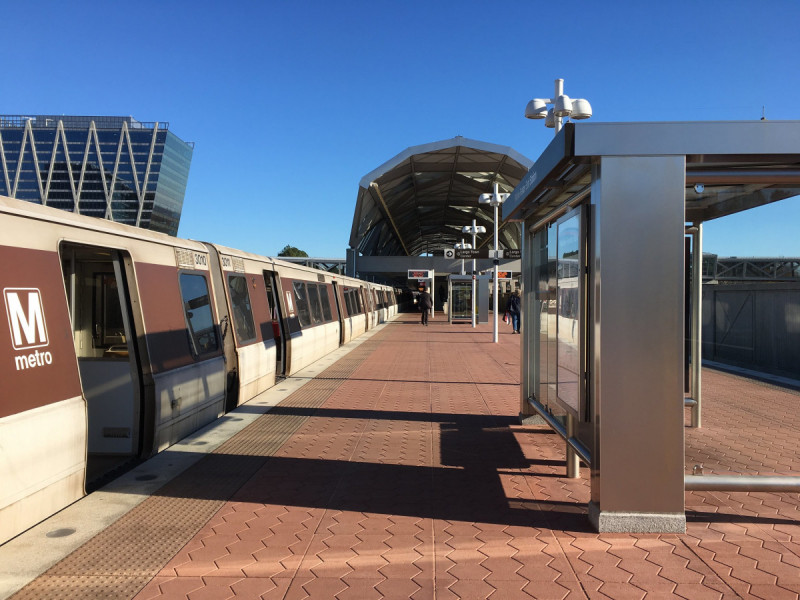Metro now controls the Silver Line tracks to Dulles and beyond. Now what?

Wiehle-Reston East WMATA Metro Silver Line station. by The West End licensed under Creative Commons.
On June 23, Metro announced that it had taken control of the Silver Line tracks running from Wiehle-Reston East out to Dulles Airport and into Ashburn. While this announcement is a step forward for the agency and the six new stations that will open when the extension comes online, there is still much more to come before passengers can ride on the trains out to Dulles.
The Silver Line project previously brought five new stations online into the Metrorail system, stretching from McLean out to Wiehle Avenue in Reston. The second phase, which Metro just recently took responsibility for, will add six more stations from Reston reaching out to Ashburn in Loudoun County.
The contract for construction of the second phase of the Silver Line has been in the works since 2013, when it was awarded at a cost of $1.178 billion (though the total estimated cost of the extension is now $2.78 billion when adding in cost increases and the new Dulles rail yard).
Major construction on the line wrapped up last year, and the Metropoltian Washington Airports Authority (MWAA), who has been responsible for building the project, declared “substantial completion” of the extension in November, 2021. That announcement allowed Metro to begin substantive testing of the extension’s power, track, signaling, and other systems to begin tying them into the rest of Metro’s network. The testing provided Metro the ability to verify MWAA’s contractor’s work and determine what work was left to be done before the agency officially accepts the extension.
Now with an Operational Readiness Date or ORD declared, Metro has indicated that the agency is ready to become responsible for maintenance of the extension, ready for testing and training before opening, and is on track to close out any major punch list items with MWAA before the start of passenger service.
Metro has not yet “accepted” the project
Declaring ORD is but one of many steps on the road to opening the Silver Line extension, and does not indicate yet that Metro has set a hard date for when the extension will open. A list of 10 conditions stand between Metro today and the start of passenger service on the new line, including ensuring MWAA has finished its required punch list work, training, figuring out equipment warranties, safety certification, and more.
When ORD was declared, custody of the extension’s assets were transferred to Metro from MWAA (yes, there was a literal handover of keys), but MWAA and other parties are still involved in the project. While Metro now manages the line, MWAA still has work that Metro is requiring of them before declaring completion. Open issues including fixing “heat tape” that keeps ice off the system’s powered third rail still have work required by MWAA’s contractor. MWAA also is still performing testing, including stray power current and thermal imaging, which Metro allowed to be deferred after ORD.
Employee training and line familiarization is one of the key upcoming steps, now that Metro has taken responsibility for the extension. Metro has hired additional employees to staff the new stations and run trains to Ashburn, but until now most haven’t been able to actually set foot on the new property. Metro’s task list includes working with its unions to schedule employees to train, learn, and work the new stations and new rail yard. New rail schedules need to be created for trains running along the new alignment, for station managers, supply runners, custodians, maintenance workers, and folks staffing up the brand new Dulles rail yard.
But one of the biggest remaining hurdles is review of the line’s safety by the Washington Metrorail Safety Commission (WMSC), the oversight body tasked with monitoring Metro. Metro’s Chief Safety Officer is the responsible person within the transit agency to sign off and declare the line safe, but must also obtain approval from the WMSC before it can be used.
“Our review has been done on an ongoing basis over the last three years,” stated WMSC personnel during their last public meeting, while noting that “it is not something that starts from scratch when Metrorail and MWAA believe work is completed.”
Metro’s internal safety certification of the line is the first in line of tasks that need to be accomplished. “Only after Metrorail completes all of the steps that its process requires, such as safety mitigations, repairs, staffing and training – can the WMSC concur that WMATA has followed the safety certification process specified by Metrorail’s policies and procedures,” tweeted the oversight agency.
Once the WMSC provides its approval, the Metro Board will formally vote to bring the extension into the Metrorail Adopted Regional System (ARS). There may still be issues that Metro has agreed to work out with MWAA at this point, but it paves the way forward to running trains with people on the new tracks.
While Metro has not set a date for when the line might open, officials have said it will be north of 90 days after ORD, but hopefully sometime this fall.
